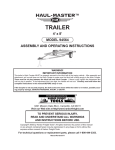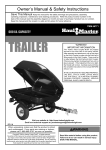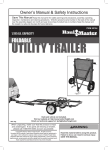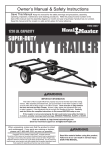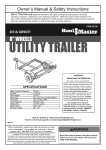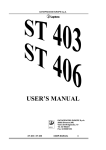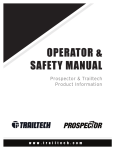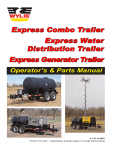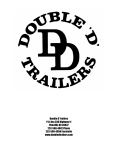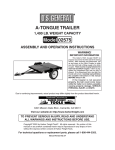Download Harbor Freight Tools 1090 lb. Capacity 40_1/2 in x 48 in Utility Trailer Product manual
Transcript
Owner’s Manual & Safety Instructions Save This Manual Keep this manual for the safety warnings and precautions, assembly, operating, inspection, maintenance and cleaning procedures. Write the product’s serial number in the back of the manual near the assembly diagram (or month and year of purchase if product has no number). Keep this manual and the receipt in a safe and dry place for future reference. ITEM 90153 WARNING! IMPORTANT INFORMATION This trailer’s Hitch Coupler MUST be properly secured to the hitch ball of the towing vehicle. After assembly and attachment, pull up and down on the Hitch Coupler to make sure the hitch ball is fitting snugly in the Hitch Coupler. There must be no play between the hitch ball and the Hitch Coupler. If there is play, tighten the Adjustment Nut until no play is present. If the Adjustment Nut is too tight, the Handle will not lock. Carefully read and follow the complete instructions in this manual BEFORE setup or use. If the coupler is not secured properly, the ball could come loose while the trailer is in motion, possibly causing property damage, SERIOUS PERSONAL INJURY, or DEATH. REV 12j Visit our website at: http://www.harborfreight.com Email our technical support at: [email protected] When unpacking, make sure that the product is intact and undamaged. If any parts are missing or broken, please call 1-800-444-3353 as soon as possible. Copyright© 2003 by Harbor Freight Tools®. All rights reserved. No portion of this manual or any artwork contained herein may be reproduced in any shape or form without the express written consent of Harbor Freight Tools. Diagrams within this manual may not be drawn proportionally. Due to continuing improvements, actual product may differ slightly from the product described herein. Tools required for assembly and service may not be included. Read this material before using this product. Failure to do so can result in serious injury. SAVE THIS MANUAL. CONTENTS SPECIFICATIONS..................................................................................... 3 GENERAL SAFETY WARNINGS AND PRECAUTIONS......................... 3 SPECIFIC PRODUCT WARNINGS AND PRECAUTIONS...................... 4 ASSEMBLY INSTRUCTIONS................................................................... 6 OPERATING INSTRUCTIONS................................................................ 15 TIRE INFORMATION............................................................................... 16 Tire Terminology Glossary...................................................................................16 Tire Markings.........................................................................................................17 Tire Inflation and Load Limit................................................................................18 TIRE CARE.............................................................................................. 19 Checking Tire Pressure........................................................................................19 Steps for Maintaining Proper Tire Pressure.......................................................19 Tire Size.................................................................................................................20 Tire Tread...............................................................................................................20 Tire Rotation..........................................................................................................20 Tire Balance and Alignment.................................................................................20 Tire Repair.............................................................................................................20 VEHICLE LOAD LIMIT............................................................................ 21 Steps for Determining Correct Load Limit..........................................................21 INSPECTION, MAINTENANCE, AND CLEANING................................. 21 PARTS LIST AND DIAGRAMS................................................................ 22 Parts List................................................................................................................22 Assembly Diagram................................................................................................23 Wiring Diagram......................................................................................................24 Item 90153 For technical questions, please call 1-800-444-3353. PAGE 2 SPECIFICATIONS Maximum Payload Capacity GVWR Net Weight Rim Size Tire Size Tire Pressure Hitch Ball Bed Frame Axle Clearance Tongue Height Safety Chain Lights & Wiring 1,090 lb. 1,250 lb. 151 lb. 4.80/4.00 - 12″ w/4 Lug Nut Pattern 4.80 x 12, 4PR 60 PSI, cold 1-7/8″, Class I 40-1/2″ x 48″ 7″ 12-1/2″ 1″ Link (Welded) 7/32″ Diameter x 42″ L w/S Hooks 12 VDC / DOT Approved GENERAL SAFETY WARNINGS AND PRECAUTIONS 1. KEEP WORK AREA CLEAN AND DRY. Cluttered, damp, or wet work areas invite injuries. 2. KEEP CHILDREN AWAY FROM WORK AREA. Do not allow children to handle this product. 3. STORE IDLE EQUIPMENT. When not in use, tools and equipment should be stored in a dry location to inhibit rust. Always lock up tools and equipment, and keep out of reach of children. 4. DO NOT USE THIS PRODUCT IF UNDER THE INFLUENCE OF ALCOHOL OR DRUGS. Read warning labels on prescriptions to determine if your judgement or reflexes are impaired while taking drugs. If there is any doubt, do not attempt to use this product. 5. USE EYE PROTECTION. Wear ANSI approved safety impact eye goggles when assembling this product. ANSI approved safety impact eye goggles are available from Harbor Freight Tools. 6. DRESS SAFELY. Do not wear loose clothing or jewelry, as they can become caught in moving parts. Wear a protective hair covering to prevent long hair from becoming caught in moving parts. If wearing a long-sleeve shirt, roll sleeves up above elbows. 7. DO NOT OVERREACH. Keep proper footing and balance at all times to prevent tripping, falling, back injury, etc. 8. INDUSTRIAL APPLICATIONS MUST FOLLOW OSHA REQUIREMENTS. 9. STAY ALERT. Watch what you are doing at all times. Use common sense. Do not use this product when you are tired or distracted from the job at hand. Item 90153 For technical questions, please call 1-800-444-3353. PAGE 3 10. CHECK FOR DAMAGED PARTS. Before using this product, carefully check that it will operate properly and perform its intended function. Check for damaged parts and any other conditions that may affect the operation of this product. Replace or repair damaged or worn parts immediately. 11. REPLACEMENT PARTS AND ACCESSORIES: When servicing, use only identical replacement parts. Only use accessories intended for use with this product. Approved accessories are available from Harbor Freight Tools. 12. MAINTAIN THIS PRODUCT WITH CARE. Keep this product clean and dry for better and safer performance. 13. MAINTENANCE: For your safety, service and maintenance should be performed regularly by a qualified technician. 14. USE THE RIGHT TOOL FOR THE JOB. Do not attempt to force small equipment to do the work of larger industrial equipment. There are certain applications for which this equipment was designed. It will do the job better and more safely at the capacity for which it was intended. Do not modify this equipment, and do not use this equipment for a purpose for which it was not intended. 15. WARNING: The warnings, precautions, and instructions discussed in this manual cannot cover all possible conditions and situations that may occur. The operator must understand that common sense and caution are factors, which cannot be built into this product, but must be supplied by the operator. SPECIFIC PRODUCT WARNINGS AND PRECAUTIONS 1. TO AVOID PERSONAL INJURY AND/OR PROPERTY DAMAGE, DO NOT EXCEED THE TRAILER’S MAXIMUM CAPACITY PAYLOAD OF 1,090 LBS. 2. BEFORE EACH USE, ALWAYS EXAMINE THE TRAILER FOR PROPER TIRE (16) AIR PRESSURE, DAMAGED TAIL LIGHTS (29, 29A), DAMAGED SIDE RUNNING LIGHTS (30), LOOSE BOLTS AND NUTS, STRUCTURAL CRACKS, BENDS, AND ANY OTHER CONDITION THAT MAY AFFECT ITS SAFE OPERATION. Do not use the Trailer even if minor damage appears. 3. NEVER ALLOW ADULTS, CHILDREN, OR PETS TO RIDE IN THE TRAILER. 4. BEFORE EACH USE, ALWAYS ATTACH THE SAFETY CHAIN (25) OF THE TRAILER TO THE TOWING VEHICLE. Make sure the Safety Chain is attached to the towing vehicle with the same length for each side. Do not allow the Safety Chain to drag on the ground. 5. ALWAYS CHECK TO MAKE SURE THE PAYLOAD BEING TRANSPORTED IS PROPERLY AND SAFELY SECURED IN THE TRAILER. Load the Trailer evenly from side to side with 60% of the load forward of the Axle (12). 6. MAKE SURE THE TOWING VEHICLE IS CAPABLE OF TOWING THE TRAILER AND ITS PAYLOAD. Make sure the hitch on the towing vehicle is capable of towing Item 90153 For technical questions, please call 1-800-444-3353. PAGE 4 the Trailer and its payload. The towing capacity of the hitch is typically stamped on the hitch drawbar. 7. MAKE SURE THE COUPLER (23) AND THE VEHICLE’S BALL HITCH (not included) ARE OF EQUAL MATING SIZE (1-7/8″) AND ARE RATED EQUAL TO OR GREATER THAN THE WEIGHT OF THE TRAILER AND ITS PAYLOAD. 8. DO NOT EXCEED 45 MILES PER HOUR WHEN TOWING THE TRAILER. Excess speed is a major cause of vehicle-trailer accidents. 9. THE TAIL LIGHT BULBS SUPPLIED WITH THIS TRAILER ARE FOR A 12 VOLT DC ELECTRICAL SYSTEM ONLY. Do not attempt to power the Light Bulbs with any other type or voltage electrical current. 10. WHENEVER POSSIBLE, PARK THE TRAILER ON A FLAT, LEVEL, PAVED, SURFACE AND CHOCK BOTH TIRES TO KEEP THE TRAILER FROM ACCIDENTLY MOVING. 11. TRAILER LICENSING NOTICE: Some states may consider this Trailer a vehicle requiring registration, licensing, and titling. Check with your State Department of Motor Vehicles for information and guidance on registering, licensing, and titling the Trailer. 12. MAINTAIN LABELS AND NAMEPLATES ON THE TRAILER. These carry important information. If unreadable or missing, contact Harbor Freight Tools for a replacement. 13. REPORTING SAFETY DEFECTS: If you believe your vehicle has a defect which could cause a crash or could cause injury or death, you should immediately inform the National Highway Traffic Safety Administration (NHTSA) in addition to notifying the manufacturer, Changzhou Nanxiashu Tool Company. If NHTSA receives similar complaints, it may open an investigation, and if it finds that a safety defect exists in a group of vehicles, it may order a recall and remedy campaign. However, NHTSA cannot become involved in individual problems between you, Harbor Freight Tools, or the manufacturer. To contact NHTSA, you may either call the Auto Safety Hotline toll-free at 1-800-424-9393 or 202-366-0123 or write NHTSA, U.S. Department, 400 7th Street SW NSA-11, Washington, D.C. 20590. You may also obtain other information about motor vehicle safety from the Hotline. Item 90153 For technical questions, please call 1-800-444-3353. PAGE 5 DON’T TIGHTEN YET! TO MAKE ASSEMBLY EASIER, wait until assembly is complete and all hardware is in place before tightening any nut or bolt. Leave hardware snug until then. ASSEMBLY INSTRUCTIONS Note:For additional references to the parts listed on the following pages, refer to the Assembly Diagram near the end of this manual. Be sure to read the Bearing Packing instructions on the last page of this manual. HEX BOLT (1) LEFT SIDE RAIL (5) CROSS MEMBER (4) REAR 1. FRONT CROSS MEMBER (4) CROSS MEMBER (4) NYLON NUT (3) (NOT SHOWN) RIGHT SIDE RAIL (5A) FIGURE A Lay out three Cross Members (4), the Right Side Rail (5A), and the Left Side Rail (5). Then assemble the parts, using Hex Bolts (1) and Nylon Nuts (3). (See Figure A.) Item 90153 For technical questions, please call 1-800-444-3353. PAGE 6 DON’T TIGHTEN YET! TO MAKE ASSEMBLY EASIER, wait until assembly is complete and all hardware is in place before tightening any nut or bolt. Leave hardware snug until then. TOW BAR (6) FRONT HEX BOLT (1) REAR SPRING SIDE PLATE (8) FIGURE B NYLON NUT (3) (NOT SHOWN) SPRING HANGER (7) 2. Turn the frame assembly upside down. Attach the Towbar (6) to the frame assembly, using Hex Bolts (1) and Nylon Nuts (3). NOTE: Observe the direction in which the Hex Bolts are inserted. (See Figure B.) 3. Attach two of the Spring Hangers (7) to the front portions of the Right Side Rail (5A) and the Left Side Rail (5), using Hex Bolts (1) and Nylon Nuts (3). Then attach the remaining two Spring Hangers, each with a Spring Side Plate (8), to the rear portions of the Right Side Rail (5A) and the Left Side Rail (5), using Hex Bolts (1) and Nylon Nuts (3). (See Figure B.) Item 90153 For technical questions, please call 1-800-444-3353. PAGE 7 DON’T TIGHTEN YET! TO MAKE ASSEMBLY EASIER, wait until assembly is complete and all hardware is in place before tightening any nut or bolt. Leave hardware snug until then. REAR U-BOLT (13) AXLE (12) NUT (11) LEFT SIDE RAIL (5) SLIPPER SPRING (9) NUT (11) SPRING HANGER (7) SPRING PLATE (14) COTTER PIN (33) HEX BOLT (10) COTTER PIN (33) HEX BOLT (10) FRONT NYLON NUT (3) FIGURE C 4. Place the Slipper Springs (9) in the Spring Hangers (7). Secure the Slipper Springs to the Spring Hangers, using Bolts (10) and Nuts (11). Then, insert a Cotter Pin (33) through the hole in the end of the Bolts and spread it. (See Figure C.) 5. Place the Axle (12) on top of the Slipper Springs (9). Position a Spring Plate (14) under the Slipper Springs. Place two U-Bolts (13) over each end of the Axle and each Slipper Spring. Then insert the U-Bolts through the holes in the Spring Plates and secure the Spring assembly, using Nylon Nuts (3). (See Figure C.) 6. Attach the Grease Fitting (35) to the Hub (15). NOTE: Every 2,000 to 3,000 miles of use, make sure to lubricate the Hub assembly with a heavy duty bearing grease. (See Figure D, next page.) 7. Carefully slide the Hubs (15) over the Spindles at each end of the Axle (12). Follow the Bearing Packing Instructions as explained on the last page of this manual. Insert the Bearing (18) and a 3/4″ Flat Washer (19) on the Spindles. Screw a Castle Nut (20) tightly onto each Spindle. Then back the Castle Nuts off slightly so that the Hubs (15) can just move freely. (See Figure D.) Item 90153 For technical questions, please call 1-800-444-3353. PAGE 8 DON’T TIGHTEN YET! TO MAKE ASSEMBLY EASIER, wait until assembly is complete and all hardware is in place before tightening any nut or bolt, except wheel lugs. Leave hardware snug until then. COTTER PIN (21) AXLE (12) SPINDLE GREASE FITTING (35) HUB (15) LUG NUT (17) 3/4″ WASHER (19) CASTLE NUT (20) TIRE (16) FIGURE D LUG NUT (17) BEARING (18) DUST CAP (22) 8. Place a Tire (16) on each Hub (15). Secure the Tires to the Hubs, using four Lug Nuts (17) per Tire. NOTE: Make sure to tighten (torque) the Lug Nuts to at least 90 ft-lb. (See Figure D.) 9. Insert a Cotter Pin (21) through the hole at the end of each Spindle of the Axle (12) and spread the Cotter Pin. (See Figure D.) 10. Press each Dust Cap (22) onto each Hub (15). (See Figure D.) 11. With assistance, turn the Trailer over so that its Tires (16) are on the floor/ground surface. 12. Attach the Coupler (23) to the Towbar (6), using Bolts (24) and Nylon Nuts (3). Lock the Coupler Trigger with the Safety Pin (37). Then, insert the R-Pin (36) through the hole in the Safety Pin to secure the Safety Pin in place. (See Figure E, next page.) 13. To attach the Safety Chain (25) to the Coupler (23), insert a Hex Bolt (1) through the center link of the Chain. Then, use a Nylon Nut (3) to secure the Safety Chain to the Coupler. NOTE: Make sure the Safety Chain is the same length on each side. (See Figure E.) 14. Attach the Tail Light Brackets (27) to the Right Side Rail (5A) and Left Side Rail (5), using Hex Bolts (1) and Nylon Nuts (3). (See Figure E.) 15. Attach the License Plate Bracket (28) and Left Tail Light (29) to the Left Side Rail (5), using Hex Bolts (1) and Nylon Nuts (3). (See Figure E.) Item 90153 For technical questions, please call 1-800-444-3353. PAGE 9 LEFT SIDE RAIL (5) COUPLER (23) TOW BAR R-PIN (36) SAFETY PIN (37) (6) BOLT (24) NUT (3) LICENSE PLATE BRACKET (28) SAFETY CHAIN (25) RIGHT SIDE RAIL (5A) LEFT TAIL LIGHT (29) SIDE RUNNING LIGHT (30) HEX BOLT (1) NYLON NUT (3) RIGHT TAIL LIGHT (29A) FIGURE E SELF TAPPING SCREW (31) TAIL LIGHT BRACKET (27) HEX BOLT (1) NYLON NUT (3) FENDER (34) 16. Attach the Right Tail Light (29A) to the Right Side Rail (5A), using Hex Bolts (1) and Nylon Nuts (3). (See Figure E.) 17. Remove the Lens from a Side Running Light (30). Insert the Wire Lead of the Side Running Light through the center hole of the Right Side Rail (5A). Attach the Side Running Light to the Right Side Rail, using the Self Tapping Screws (31). Then, reattach the Lens to the Side Running Light. Repeat this Step for the remaining Side Running Light and the Left Side Rail (5). (See Figure E.) 18. Attach a Fender (34) to the Right Side Rail (5A) and Left Side Rail (5), using Hex Bolts (1) and Nylon Nuts (3). (See Figure E.) TIGHTEN ALL HARDWARE! Now that frame is completely assembled, retrace all assembly steps and make sure that all hardware is properly wrench‑tightened. Also, tighten lug nuts/lug bolts to 90 ft-lb. Item 90153 For technical questions, please call 1-800-444-3353. PAGE 10 WHITE (GROUND) WIRE CLIP YELLOW GREEN WIRE FROM SIDE RUNNING LIGHT (30) WIRE FROM SIDE RUNNING LIGHT (30) BROWN BROWN LEFT SIDE RAIL (5) RIGHT SIDE RAIL (5A) LEFT TAIL LIGHT (29) RIGHT TAIL LIGHT (29A) BROWN BROWN YELLOW GREEN FIGURE F 19. To install the Wiring Harness on the Trailer, use a Self Tapping Screw (31) to attach the White Ground Wire located at the Plug end of the Wiring Harness to the small mounting hole in the Towbar (6). (See Figure F.) 20. Leave about 18″ of wire beyond the Coupler (23), and run the Wiring Harness along the inside of the Towbar (6) to the front Cross Member (4). Then, split the Yellow/ Brown Wires from the Green/Brown Wires. (See Figure F.) 21. Run the Yellow/Brown Wires along the inside of the front Cross Member (4) to the Side Running Light (30) located on the Left Side Rail (5). Then, run the Green/ Brown Wires along the inside of the front Cross Member (4) to the other Side Running Light located on the Right Side Rail (5A). (See Figure F.) 22. Connect the Wire Lead from the two Side Running Lights (30) to the Brown Wire on each side of the Trailer. Then, insert Wire Clips along the entire length of the Side Rails of the Trailer to hold down the Wiring Harness. (See Figure F.) 23. Run the Yellow/Brown Wires to the Left Tail Light (29). Strip the ends of the Wires about 3/4″. Connect the Yellow Wire to the Red Wire of the Left Tail Light. Then, connect the Brown Wire to the two Black Wires of the Left Tail Light. (See Figure F.) 24. Run the Green/Brown Wires to the Right Tail Light (29A). Strip the ends of the Wires about 3/4″. Connect the Green Wire to the Red Wire of the Right Tail Light. Then, connect the Brown Wire to the two Black Wires of the Right Tail Light. (See Figure F.) 25. NOTE: It is recommended that only a qualified technician perform the electrical service that may be needed to enable your particular make/model vehicle to power the Trailer’s 12 volt DC lighting system. Item 90153 For technical questions, please call 1-800-444-3353. PAGE 11 3/4″ THICK PLYWOOD MEASURE WIDTH & LENGTH OF TRAILER FRAME. 3/8″ DIA. HOLE CUT PLYWOOD TO MATCH WIDTH & LENGTH OF TRAILER FRAME. FIGURE G 3/8″ DIA. HOLE 26. To attach a bed (not included) to the frame of the Trailer, you will need the following materials and parts: a. Qty. 1: 3/4″ thick Plywood (not included). b. Qty. 12: 3/8″ x 1-1/2″ Cross Head Bolts (not included). c. Qty. 12: 3/8″ Flat Washers (not included). d. Qty. 12: 3/8″ Spring Washers (not included). e. Qty. 12: 3/8″ Hex Nuts (not included). 27. Carefully measure the width and length of the Trailer frame. Then, cut the 3/4″ the same dimensions as the Trailer Frame. (See Figure G.) 28. Drill three evenly spaced, 3/8″ diameter, holes in the inner flange of each side of the Trailer. Then, drill three corresponding, 3/8″ diameter, holes in each side of the plywood. (See Figure G.) 3/8″ X 1-1/2″ CROSS HEAD BOLT 3/8″ FLAT WASHER 3/4″ THICK PLYWOOD FIGURE H 3/8″ SPRING WASHER 3/8″ HEX BOLT 29. With assistance, place the 3/4″ plywood on the Trailer frame and align the predrilled 3/8″ holes in the plywood with the pre-drilled 3/8″ holes in the Trailer frame. (See Figure H.) 30. Secure the 3/4″ plywood to the Trailer frame, using twelve 3/8″ x 1-1/2″ Cross Head Bolts, twelve 3/8″ Flat Washers, twelve 3/8″ Spring Washers, and twelve 3/8″ Hex Nuts (none included). (See Figure H.) Item 90153 For technical questions, please call 1-800-444-3353. PAGE 12 31. To attach rails (not included) to the Trailer, you will need the following materials and parts: a. Qty. 4: 1″ x 4″ x 46″ lumber (not included). b. Qty. 4: 1″ x 4″ x 37″ lumber (not included). c. Qty. 8: 1″ x 4″ x 12″ lumber (not included). d. Qty. 8: 2″ x 2″ x 3-1/2″ Steel Angle (not included). e. Qty. 32: 3/8″ x 1-3/4″ Hex Bolt (not included). f. Qty. 32: 3/8″ x 2-3/8″ Hex Bolt (not included). g. Qty. 64: 3/8″ Spring Washer (not included). h. Qty. 64: 3/8″ Flat Washer (not included). i. Qty. 64: 3/8″ Hex Nut (not included). STAKE 3-1/2″ 1-1/2″ 12″ 3-1/2″ FRONT END/BACK END RAIL 1-1/2″ 37″ 1-1/2″ SIDE RAIL 3-1/2″ 46″ 3-1/2″ STEEL ANGLE FIGURE I 2″ 2″ 32. Cut the Stakes, Front End Rails, Back End Rails, and Side Rails to the sizes indicated in the illustration. (See Figure I.) 33. Drill 3/8″ holes through the Stakes as indicated in the illustration. (See Figure I.) Item 90153 For technical questions, please call 1-800-444-3353. PAGE 13 FRONT END RAIL STEEL ANGLE STAKE BACK END RAIL 3/8″ X 2-3/8″ HEX BOLT 3/8″ FLAT WASHER 3/8″ SPRING WASHER 3/8″ HEX NUT 3/8″ X 1-3/4″ HEX BOLT 3/8″ FLAT WASHER 3/8″ SPRING WASHER 3/8″ HEX NUT FIGURE J 34. To determine where to drill 3/8″ holes in the Front End Rails and Back End Rails, place the eight pre-drilled Stakes in the eight Stake Slots of the Trailer and mark the Front/Back End Rails with a pencil. (See Figure J.) 35. Attach the four Side Rails and Front/Back Rails to the Stakes, using the 3/8″ x 2-3/8″ Hex Bolts, 3/8″ Flat Washers, 3/8″ Spring Washers, and 3/8″ Hex Nuts. (See Figure J.) 36. Attach the Steel Angles to the Side Rails and Front/Back Rails, using the 3/8″ x 1-3/4″ Hex Bolts, 3/8″ Flat Washers, 3/8″ Spring Washers, and 3/8″ Hex Nuts. (See Figure J.) Item 90153 For technical questions, please call 1-800-444-3353. PAGE 14 OPERATING INSTRUCTIONS CAUTION 1. Only use a 1-7/8″ ball hitch (not included) on the towing vehicle. 2. NOTE: To reduce friction between the hitch ball and Coupler (23), apply a layer of heavyweight grease over the hitch ball. 3. Temporarily remove the ″R″ Pin (36) and Safety Pin (37). Then, pull up on the Trigger and lift up on the Handle. (See Figure K.) Care must be taken when backing up the Trailer; only back up the trailer on a straight path. If the Trailer is allowed to turn off the straight path while backing up, the Trailer could jackknife, causing severe damage to the trailer and to the towing vehicle. TRIGGER “R” PIN (36) HANDLE SAFETY PIN (37) ADJUSTMENT NUT COUPLER (23) HITCH BALL (NOT INCLUDED) SAFETY CHAIN (25) FIGURE K 4. With assistance, place the Coupler (23) over the vehicle’s hitch ball and pull back on the Trigger and push down on the Handle until the Trigger locks in the slot. Pull up and down on the Coupler to make sure the hitch ball is fitting snugly in the Coupler. There should be no play between the hitch ball and Coupler. IMPORTANT - If there is play, tighten the Adjustment Nut until no play is present: After unlocking the Handle, the Nut retaining plate (holding the adjusting nut in place) needs to be pressed back while the Nut is tightened. After Nut is tightened, the retaining plate needs to fit in place against the flats of the Nut to prevent it from moving. This adjustment should be done by 2 people. If the Adjustment Nut is too tight, the Handle will not lock. After the Adjustment Nut is properly adjusted, pull back on the Trigger and push down on the Handle until the Trigger locks in the slot. Pull up on Handle firmly to make sure the Trigger is locked in place and the Handle cannot move. Replace the Safety Pin and ″R″ Pin. (See Figure K.) 5. Make sure to attach each side of the Safety Chain (25) equally to the towing vehicle’s rear bumper or frame. (See Figure K.) 6. Connect the Tail Light Wiring Assembly to the towing vehicle’s 12 Volt DC system. NOTE: Make sure to consult the operator’s manual of the towing vehicle for proper connection instructions. 7. When towing the Trailer over long distances stop and check the tightness of all connections, Side Running Lights (30), and Tail Lights (29, 29A) at least every 100 miles. 8. Carry emergency flares, and fire extinguisher, if required for operation in your state. Carry extra bulbs and fuses if towing the Trailer at night over long distances. Item 90153 For technical questions, please call 1-800-444-3353. PAGE 15 TIRE INFORMATION Tire Terminology Glossary • Accessory weight means- the combined weight of automatic transmission, power steering, power brakes, power windows, power seats, radio, and heater, to the extent that these items are available as factory-installed equipment. • Carcass means- the tire structure except for the tread which provides the major portion of the tire’s capability to deflect in response to the vertical loads and tractive forces that the tire transmits from the roadway to the non-pneumatic rim, the wheel center member, or the vehicle and which attaches to the vehicle or attaches, either integrally or separably, to the wheel center member or non-pneumatic rim. • Carcass separation means- the pulling away of the carcass from the non-pneumatic rim or wheel center member. • Chunking means- the breaking away of pieces of the carcass or tread. • Cracking means- any parting within the carcass, tread, or any components that connect the tire to the wheel center member. • Curb weight means- the weight of a motor vehicle with standard equipment including the maximum capacity of fuel, oil, and coolant, and, if so equipped, air conditioning and additional weight optional engine. • Load rating means- the maximum load a tire is rated to carry. • Maximum loaded vehicle weight means- the sum of: a.Curb weight; b.Accessory weight; c.Vehicle capacity weight; and d.Production options weight. • Maximum tire width means- the greater of either the linear distance between the exterior edges of the carcass or the linear distance between the exterior edges of the tread, both being measured parallel to the rolling axis of the tire. • Normal occupant weight means- 68 kilograms times the number of occupants. • Occupant distribution means- distribution of occupants in a vehicle. • Production options weight means- the combined weight of those installed regular production options weighing over 2.3 kilograms in excess of those standard items which they replace, not previously considered in curb weight or accessory weight, including heavy duty brakes, ride levelers, roof rack, heavy duty battery, and special trim. • Tread means- that portion of the tire that comes in contact with the road. • Tread separation means- pulling away of the tread from the carcass. • Vehicle capacity weight means- the rated cargo and luggage load plus 68 kilograms times the vehicle’s designated seating capacity. • Vehicle maximum load on the tire means- that load on an individual tire that is determined by distributing to each axle its share of the maximum loaded vehicle weight and dividing by two. • Vehicle normal load on the tire means- that load on an individual tire that is determined by distributing to each axle its share of the curb weight, accessory weight, and normal occupant weight and dividing by 2. Item 90153 For technical questions, please call 1-800-444-3353. PAGE 16 Tire Markings Inner diameter in inches Section width in inches Load index and Speed rating* European tire certificate* U.S. DOT tire identification number Tire ply composition and materials used Maximum permissible inflation pressure Maximum load rating Trailer tire *Information not required by U.S. DOT • Section width- This number gives the width of the tire in inches. The larger the number, the wider the tire. (The markings on the example tire diagram show 4.80. The markings on your tire may differ.) • Inner diameter- This number gives the inner diameter of the tire in inches. This is also the rim diameter in inches. (The markings on the example tire diagram show 12. The markings on your tire may differ.) • U.S. DOT tire identification number- This begins with the letters “DOT” and indicates that the tire meets all federal standards. The next two numbers or letters are the plant code where it was manufactured, and the last four numbers represent the week and year that the tire was built. For example, the numbers 2107 mean the 21st week of 2007. Any other numbers used are marketing codes used at the manufacturer’s discretion. This information is used to contact consumers if a tire defect requires a recall. • Maximum Load Rating- This number indicates the maximum load in kilograms and pounds that can be carried by the tire. Item 90153 For technical questions, please call 1-800-444-3353. PAGE 17 Code 71 72 73 74 75 76 77 78 Pounds 761 783 805 827 853 882 908 937 Code 79 80 81 82 83 84 85 86 Load Index Rating Codes Pounds 963 992 1,019 1,047 1,074 1,102 1,135 1,168 Code Pounds 87 88 89 90 91 92 93 94 Code 1,201 1,235 1,279 1,323 1,356 1,389 1,433 1,477 95 96 97 98 99 100 101 102 Pounds Code 1,521 1,565 1,609 1,653 1,709 1,764 1,819 1,874 103 104 105 106 107 108 109 110 Pounds 1,929 1,984 2,039 2,094 2,149 2,205 2,271 2,337 • Load index- This is a measurement of how much weight each tire can support. See chart above. (The markings on the example tire diagram show 71. The markings on your tire may differ.) Note: You may not find this information on all tires because it is not required by law. • Speed Rating- The speed rating denotes the speed at which a tire is designed to be driven for extended periods of time. This does not indicate that the vehicle Tire Speed Rating Codes or rims can safely reach or maintain that speed. These Code MPH Code MPH Code MPH ratings are listed to the right. (The markings on the F 50 N 87 U 124 example tire diagram show M. The markings on your G 56 P 94 H 130 J 62 Q 100 V 149 tire may differ.) Note: You may not find this information K 68 R 106 Z 149 on all tires because it is not required by law. L 75 S 112 W 168 • Tire Ply Composition and Materials Used- The M 81 T 118 Y 186 number of plies indicates the number of layers of rubbercoated fabric in the tire. In general, the greater the number of plies, the more weight a tire can support. Tire manufacturers also must indicate the materials in the tire, which include steel, nylon, polyester, and others. • Maximum Permissible Inflation Pressure- This number is the greatest amount of air pressure that should ever be put in the tire under normal driving conditions. Tire Inflation and Load Limit The weight of cargo should never exceed 493 kg or 1,090 lb. TIRE SIZE COLD TIRE PRESSURE FRONT 4.80/4.00-12 410 kPa, 60 PSI REAR NONE NONE SPARE NONE NONE SEE OWNER’S MANUAL FOR ADDITIONAL INFORMATION. 12a TIRE AND LOADING INFORMATION MODEL 90153 Tire and Loading Information Placard Tire and Loading Information Placard Location The Tire and Loading Information Placard displays the cold tire inflation pressure and the load limit for this vehicle. See the Tire Care section starting on the following page for an explanation of tire pressure and see the Vehicle Load Limit section following that for an explanation of load limit. Item 90153 For technical questions, please call 1-800-444-3353. PAGE 18 TIRE CARE gently pressing on the tire valve stem with the edge of your tire gauge until you get to the correct pressure. If the vehicle have been driven within the past three hours and the tire pressure is too high on any tires, then recheck the pressure once the tires have been allowed to sit motionless for at least three hours. Checking Tire Pressure Note: Underinflated tires can decrease handling, stopping performance, traction, tire life, and load-carrying capability, in addition to causing other negative and hazardous effects, including tire failure. Overinflated tires are at greater risk of an impact break, where the tread and casing break when striking a hard edge, often opening a huge gash across the tread. Incorrect inflation pressure also increases tires wear rate. Therefore, it is important to keep tires inflated properly. 4. If the tire pressure is too low, note the difference between the measured tire pressure and the correct tire pressure. These “missing” pounds of pressure are what you will need to add. 5. At a service station, add the missing pounds of air pressure to each tire that is underinflated. • Tires can suddenly lose air if the tire strikes a pothole, curb, or other object. 6. Check all the tires to make sure they have the same air pressure. • It is usually not possible to determine underinflation of radial tires by visual inspection. 7. If the tires’ pressure was not measured “cold”, then the pressure should be rechecked with the tires cold as soon as possible. Check all tires’ pressure at least monthly, due to the following factors: • Most tires naturally lose air gradually. This vehicle has 60 PSI recommended cold tire inflation pressure. The term “cold” in this manual does not refer to the temperature outside, but it refers to the fact that a tire that has not been driven for a period is cooler (and therefore has lower pressure) than a tire that has been driven on. Tires heat up while being driven on. To check (or fill to) a tire’s cold inflation, the tire must have not been driven for more than a mile or two for at least three hours. If you check a tires pressure when it is not “cold”, the pressure will appear higher than the actual cold tire inflation. Steps for Maintaining Proper Tire Pressure 1. Locate the recommended tire pressure on the vehicle’s tire information placard, certification label, or in the owner’s manual. This trailer has 60 PSI recommended cold tire inflation pressure. 2. Measure and record the tire pressure of all tires. 3. If the tire pressure is too high in any of the tires and the tires have not been driven for at least three hours, slowly release air by Item 90153 Tire Size To maintain safety, only purchase new tires of the same size as the original tires. Look at the Tire and Loading Information Placard, the Specifications Chart in this manual, or the sidewall of the tire being replaced. If you have any doubt about selecting the correct size, consult a tire dealer. Tire Tread The tire tread provides traction that prevents your vehicle from slipping, especially if the road is wet or icy. Tires are unsafe and should be replaced when the tread is worn down to 1/16″. Measure tread depth using a tread depth indicator (not included). Tire Rotation Every 5,000 miles the left and right tires should be switched. This will cause the tires to wear more evenly and last longer. For technical questions, please call 1-800-444-3353. PAGE 19 Tire Balance and Alignment Tire Repair The tires need to be balanced to prevent vibration when driving. This involves attaching small weights to the rim to offset small differences in rim and tire weight. The tires also need to be aligned properly. Alignment is the orientation of the tires to the road surface and their being parallel. This helps the tires to wear evenly, and provide better traction. Both tire balance and alignment require specialized equipment that is not provided with this vehicle. To properly repair a punctured tire, the hole needs to be properly plugged and patched from the inside of the tire. Tread punctures can be repaired if they are not too large. Sidewall punctures should not be repaired, the tire needs to be replaced if the sidewall is damaged. Tires should be removed from the rim to be inspected before being plugged and patched. A qualified mechanic should remove the tire from the rim, perform the repair, and remount the tire. VEHICLE LOAD LIMIT Steps for Determining Correct Load Limit 1. Locate the statement “The weight of cargo should never exceed XXX kilograms or XXX pounds” on your vehicle’s placard. 2. That figure equals the available amount of cargo and luggage load capacity. 3. Determine the combined weight of luggage and cargo being loaded on the vehicle. That weight may not safely exceed the available cargo and luggage load capacity. 4. If the trailer’s load exceeds the cargo and luggage load capacity, then the trailer be unsafe resulting in hazardous effects, such as: Trailer’s tires will not be able to maintain traction properly, and stopping distance will be increased significantly. INSPECTION, MAINTENANCE, AND CLEANING 1. BEFORE EACH USE, inspect the general condition of the Trailer. Check for loose Bolts and Nuts, misalignment or binding of moving parts, cracked, bent, or broken parts, excessively worn Safety Chain, damaged Tail Lights/Side Running Lights/Wiring Harness, loose Lug Nuts, loose Hitch connection, and any other condition that may affect its safe operation. If abnormal noise or vibration occurs, have the problem corrected before further use. Do not use damaged equipment. 2. BEFORE EACH USE, check the Tires for wear and proper inflation (60 PSI). 3. BEFORE EVERY USE AND AT 500 MILE INTERVALS DURING EVERY TRIP, check and tighten the Tire Lug Nuts. Torque from 85 to 90 ft-lb. 4. EVERY 2,000 TO 3,000 MILES OF USE, lubricate the Hub Assemblies with a heavy weight bearing grease. Follow the Bearing Packing Instructions as explained on the last page of this manual. After each Hub Assembly is reassembled, tighten the Castle Nut until the wheel starts spinning with slight resistance. Loosen the Castle Nut about 1/6 turn from this point. Insert a new Cotter Pin through the Castle Nut and the hole in the axle. Bend the Pin back, locking it and the Nut in place. 5. TO CLEAN, use only water and a mild detergent. Item 90153 For technical questions, please call 1-800-444-3353. PAGE 20 PARTS LIST AND DIAGRAMS PLEASE READ THE FOLLOWING CAREFULLY THE MANUFACTURER AND/OR DISTRIBUTOR HAS PROVIDED THE PARTS LIST AND ASSEMBLY DIAGRAM IN THIS MANUAL AS A REFERENCE TOOL ONLY. NEITHER THE MANUFACTURER OR DISTRIBUTOR MAKES ANY REPRESENTATION OR WARRANTY OF ANY KIND TO THE BUYER THAT HE OR SHE IS QUALIFIED TO MAKE ANY REPAIRS TO THE PRODUCT, OR THAT HE OR SHE IS QUALIFIED TO REPLACE ANY PARTS OF THE PRODUCT. IN FACT, THE MANUFACTURER AND/OR DISTRIBUTOR EXPRESSLY STATES THAT ALL REPAIRS AND PARTS REPLACEMENTS SHOULD BE UNDERTAKEN BY CERTIFIED AND LICENSED TECHNICIANS, AND NOT BY THE BUYER. THE BUYER ASSUMES ALL RISK AND LIABILITY ARISING OUT OF HIS OR HER REPAIRS TO THE ORIGINAL PRODUCT OR REPLACEMENT PARTS THERETO, OR ARISING OUT OF HIS OR HER INSTALLATION OF REPLACEMENT PARTS THERETO. Note: Some parts are listed and shown for illustration purposes only, and are not available individually as replacement parts. Parts List Part Description Qty Part Description Qty 1 Hex Bolt (10 x 20 mm) 32 20 Castle Nut 2 3 Nylon Nut (M10) 42 21 Cotter Pin (4 mm) 2 4 Cross Member 3 22 Dust Cap 2 5 Left Side Rail 1 23 Coupler 1 Right Side Rail 1 24 Bolt (10 x 90 mm) 2 6 Tow Bar 1 25 Safety Chain 1 7 Spring Hanger 4 27 Tail Light Bracket 2 8 Spring Side Plate 2 28 License Plate Bracket 1 Left Tail Light 1 Right Tail Light 1 5A 9 Slipper Spring 2 29 10 Hex Bolt (14 x 80 mm) 4 29A 11 Nut (M14) 4 30 Side Running Light 2 12 Axle 1 31 Self Tapping Screw 4 13 U-Bolt (10) 4 32 Seal 2 14 Spring Plate 2 33 Cotter Pin (3 mm) 4 15 Hub 2 34 Fender 2 16 Tire 2 35 Grease Fitting 2 17 Lug Nut 8 36 R-Pin (3 mm) 1 18 Bearing 2 37 Safety Pin (10 x 25 mm) 1 19 Washer (3/4″) 2 Item 90153 For technical questions, please call 1-800-444-3353. PAGE 21 Assembly Diagram 23 5 4 25 6 28 29 5A 4 31 30 4 34 14 12 29A 27 33 32 13 35 1: HEX BOLTS (10 X 20 MM) NOT SHOWN. 3: NYLON NUTS (M10) NOT SHOWN. 8: SPRING SIDE PLATES NOT SHOWN. 10: HEX BOLTS (14 X 80 MM) NOT SHOWN. 11: NUTS (M14) NOT SHOWN. 17: LUG NUTS NOT SHOWN. 21: COTTER PINS (4 MM) NOT SHOWN. 24: BOLTS (10 X 90 MM) NOT SHOWN. 36: R-PIN (3 MM) NOT SHOWN. Item 90153 7 15 7 16 18 19 20 22 For technical questions, please call 1-800-444-3353. PAGE 22 Wiring Diagram Note:Some trailer tail lights will have two leads instead of three. They connect to the harness leads the same way; brown to brown, color to color. BEARING PACKING INSTRUCTIONS Important Read and adhere to the following instructions; failure to read and obey all of the following instructions COMPLETELY will void the warranty and can result in damage to the trailer, property damage, or SERIOUS PERSONAL INJURY. Whenever a hub is disassembled (if a hub on a new unit requires assembly or a hub is disassembled for maintenance), the following procedure MUST be followed. 1. Using a suitable solvent, thoroughly clean the bearings and the rest of the parts in the Hub assembly of all grease, dirt, metal shavings, or any other foreign object. The parts must be cleaned even if they are new or appear clean. 5. With the grease-filled bearing packer in one hand and the bearing in the other, press the bearing into the grease, forcing the grease inside the slots in the bearing, continue doing this until every slot in the bearing is completely full of grease. 2. Allow all pieces to dry completely. 6. 3. Make sure that your hands are thoroughly clean and the bearing packer (not included) is also thoroughly clean. Finish assembling the hub/wheel assembly as explained in this manual, being careful not to get any dirt or debris on any part of the assembly. 4. Place fresh, clean bearing grease in the packer. Item 90153 For technical questions, please call 1-800-444-3353. PAGE 23 Limited 90 Day Warranty Harbor Freight Tools Co. makes every effort to assure that its products meet high quality and durability standards, and warrants to the original purchaser that this product is free from defects in materials and workmanship for the period of 90 days from the date of purchase. This warranty does not apply to damage due directly or indirectly, to misuse, abuse, negligence or accidents, repairs or alterations outside our facilities, criminal activity, improper installation, normal wear and tear, or to lack of maintenance. We shall in no event be liable for death, injuries to persons or property, or for incidental, contingent, special or consequential damages arising from the use of our product. Some states do not allow the exclusion or limitation of incidental or consequential damages, so the above limitation of exclusion may not apply to you. THIS WARRANTY IS EXPRESSLY IN LIEU OF ALL OTHER WARRANTIES, EXPRESS OR IMPLIED, INCLUDING THE WARRANTIES OF MERCHANTABILITY AND FITNESS. To take advantage of this warranty, the product or part must be returned to us with transportation charges prepaid. Proof of purchase date and an explanation of the complaint must accompany the merchandise. If our inspection verifies the defect, we will either repair or replace the product at our election or we may elect to refund the purchase price if we cannot readily and quickly provide you with a replacement. We will return repaired products at our expense, but if we determine there is no defect, or that the defect resulted from causes not within the scope of our warranty, then you must bear the cost of returning the product. This warranty gives you specific legal rights and you may also have other rights which vary from state to state. 3491 Mission Oaks Blvd. • PO Box 6009 • Camarillo, CA 93011 • (800) 444-3353
























